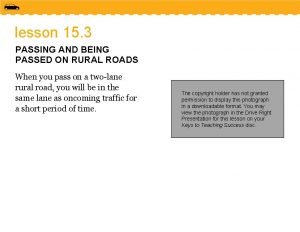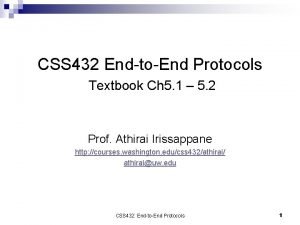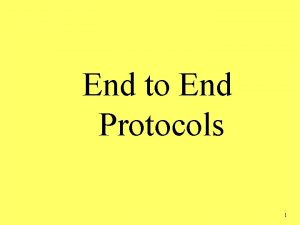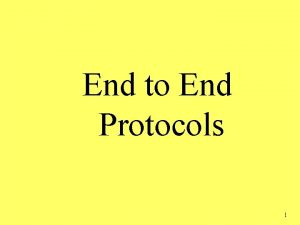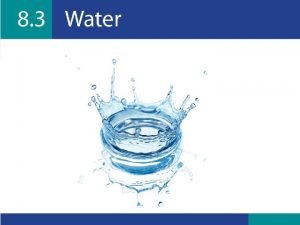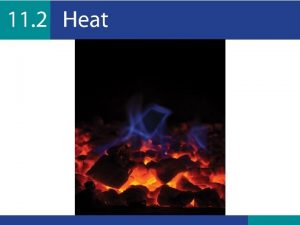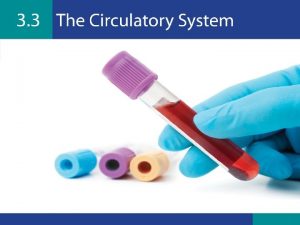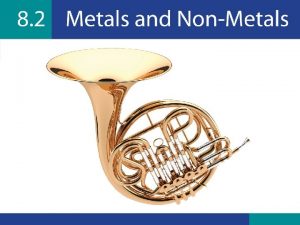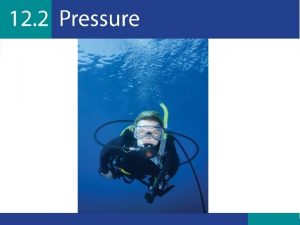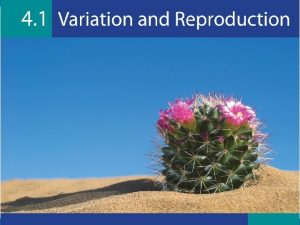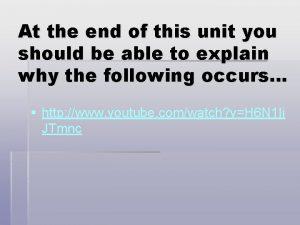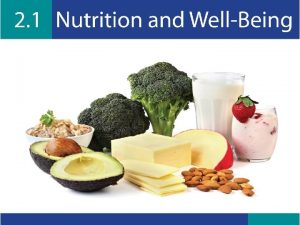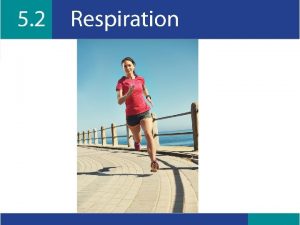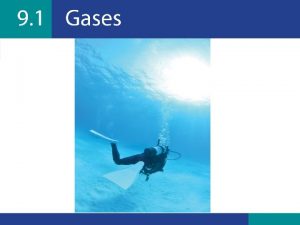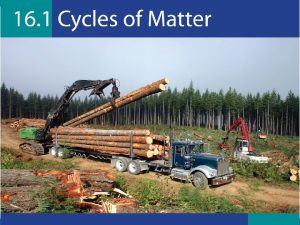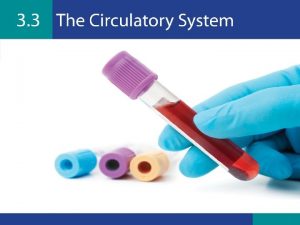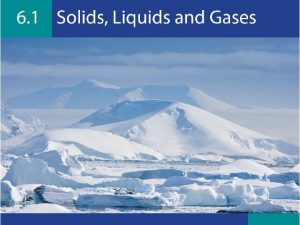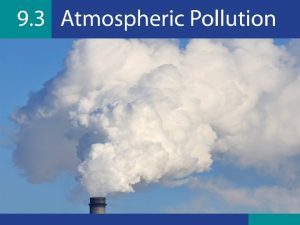At the end of this unit you should



















































- Slides: 51


At the end of this unit you should: 1. Know what a habitat is, how they vary and how different habitats support different organisms. 2. Know that habitats can be affected by environmental factors, light, availability of water, amount of nutrients present. 3. Know what an adaptation is, give examples of adaptations and explain how they help the plant or animal survive. 4. Recognise what resources plants and animals compete for. 5. Be able to explain why at times resources are low and competition between organisms increases. 6. Be able to describe how plants and animals have to depend on each other. 7. Be able to conduct a habitat study. 8. Understand how matter and energy flow through a food chain.

adaptation food chain biosphere food web camouflage habitat characteristic interdependence communities matter competition population consumer producer ecosystem resources environment

(a) What organisms are producers and why are they called producers? Plants are producers as they bring energy into the food chain or food web. (b) An animal that eats an organism is referred to as a ____? Consumer.

(c) If the caterpillar were to become extinct, what would happen to the number of birds in existence? Would there be an effect on the number of hawks in that food chain? If the caterpillar became extinct, the number of birds would decrease, as their food source would be extinct. Similarly, the number of hawks would decrease, as their food source will also have decreased in number.

(d) Referring to the food web in Fig. 05. 03. 01, write out three separate food chains, using arrows to represent the transfer of energy and matter. Shrubs Caterpillar Shrubs Greenfly Owl tree Caterpillar Shrew Ladybird Blackbird Owl Blackbird Hawk

(e) Why, do you think, are food chains only four or five links long? There is little energy transferred from the fourth to the fifth level. Therefore there would not be enough energy provided or transferred after these levels.

(f) Construct a food chain with arrows for each of these descriptions: (i) Grass gets eaten by a field mouse which gets eaten by a hawk. Grass Field mouse Hawk (ii) An owl eats a spider which ate a ladybird which fed on caterpillars which ate leaves. Leaf Caterpillar Ladybird Spider Owl

(g) Place the following food chains into one food web by drawing out the links. Always begin with the producer(s) and use arrows to represent who eats what and the transfer of energy and cycle of matter. (i) Grass grasshopper squirrel hawk. (ii)Dandelion grasshopper spider field mouse hawk.


Producer: A plant that brings energy into the food chain. Consumer: An organism that eats another.

Habitat: A place where a plant or animal lives. Ecosystem: An area where plants and animals live and interact with each other and with their environment.

(a) Explain why energy is lost as it flows from one link to the next in a food web. The energy gets used up by the organism at that level. The organism needs the energy to carry out daily activities (walking, eating, sleeping, etc. )

(b) What is a habitat? A place where a plant or animals lives.

(c) What must a habitat provide in order for a plant and an animal to survive there? All of the resources that a plant and animal needs to survive in that particular habitat.

(d) If the habitat did not provide for the animals, what would they have to do? They would have to move to new area to live, or perish.

(e) We’ve seen that a tree is a habitat. Name parts of the tree that could be habitats for animals. Leaves; bark; branches; the fruit; roots.

LIGHTBULB QUESTION (a) So they have a wide view to see their predators. (b) So they can absorb more sunlight to allow photosynthesis to occur. (c) So they can kill and eat their prey.

(a) Look at the images of the different environments in Fig. 05. 03. 05 and imagine yourself standing in one of them. Describe briefly what it would be like to live there. Example: The Forest There would be plenty of food to eat and drink. It would be cold as no sun would get through the thick canopy. There would be plenty of shelter to build a home from. There would also be a lot of other animals around. These animals would be big and small as the vegetation would allow a good diversity of animal to survive. The forest floor would not have many flowers as the leaves from the taller plants / trees would absorb most of the sunlight needed for them to grow.

(b) How might plants and animals be adapted to living in each particular habitat and the environment around them? Give one example of a plant and one example of an animal adaptation for each habitat. Plants and animals have the characteristics to survive in the habitat. Desert Plant: Cacti – some have thick fleshy leaves to store water as it is in short supply. Animal: Will have a layer of thin fur to allow heat to escape.

(b) How might plants and animals be adapted to living in each particular habitat and the environment around them? Give one example of a plant and one example of an animal adaptation for each habitat. Plants and animals have the characteristics to survive in the habitat. Artic/snow area Plant: They will usually grow small and close to the ground. This is because there is a lack of nutrients available in the soil. Growing closer to the ground protects them from freezing. Animal: Thick fur to keep heat in and a thick layer of fat to help with insulation.

(b) How might plants and animals be adapted to living in each particular habitat and the environment around them? Give one example of a plant and one example of an animal adaptation for each habitat. Plants and animals have the characteristics to survive in the habitat. Urban Plant: Can withstand small levels of pollution from vehicles. Animal: Not afraid of vehicles and some have become adapted to the presence of humans.

(b) How might plants and animals be adapted to living in each particular habitat and the environment around them? Give one example of a plant and one example of an animal adaptation for each habitat. Plants and animals have the characteristics to survive in the habitat. Ocean Plant: Some plants have adapted to only needing a small amount of sunlight if they live deep in the ocean bed. Leaves and stems are flexible to move with the water currents. Some plants have air spaces that hold them upright in the water. Animal: Have adapted to hiding to avoid predators. Some animals stay in groups to protect themselves.

(b) How might plants and animals be adapted to living in each particular habitat and the environment around them? Give one example of a plant and one example of an animal adaptation for each habitat. Plants and animals have the characteristics to survive in the habitat. Forest Plant: Some plants, mosses for example, will grow on top of other plants. Animal: Some can have tails to wrap around trees, to enable them to move from tree to tree and to access food. Some animals have large eyes so they can view the forest floor, where there is very little sunlight and poor visibility.

(a) In small groups, look at the images in Fig. 05. 03. 08. Make a list of all the differences you can see between the two plants, and between the two owls. Plants: Leaf size; thorns on the rose stem; one plant’s ability to survive on water; different flowers produced; the surface of the rose plant’s leaves are shiny while the lily’s are not. Owls: Body size; shape of face; colour of coat; size and shape of eye.

(b) Discuss why these differences might exist and the benefits of each difference. Plants: Different flowers colours to attract different insects; broad leaf to trap more sunlight; thorns on the rose plant to protect it from predators; surface of the rose leaf has a cuticle layer to allow it to be waterproof. Owl: Colour of coat allowing it to be camouflaged; shape of eyes aiding specific focus and vision; different body size to adapt to temperatures in their natural habitats.

(c) Suggest how these differences could affect each plant’s/animal’s interactions in the habitat. These differences allow the plant/owl to survive in their specific habitats. If the differences did not exist, they would all only be suited to one habitat, leading to competition for space and food, thus depleting stock and endangering the species. Differences/adaptations in species allows for proliferation of the species.

Adaptation: A characteristic or feature of an organism that increases its chances of survival.

LIGHTBULB QUESTION Not enough sunlight penetrates through to the forest floor to allow plants to photosynthesise and grow.

Competition: The battle for resources between organisms to ensure survival. Interdependence: The dependence of organisms on each other for survival.

Look at the images in Fig. 05. 03. 10. Make a list of where interdependence might be demonstrated in each image and briefly outline how the relationship works. Buffalo and birds: the birds remove the insects that may live on the buffalo’s back. The birds get food and the buffalo has the insects removed.

Look at the images in Fig. 05. 03. 10. Make a list of where interdependence might be demonstrated in each image and briefly outline how the relationship works. Deer and grass: The deer get food from the grass and the grass get their pollen dispersed by the deer.

Look at the images in Fig. 05. 03. 10. Make a list of where interdependence might be demonstrated in each image and briefly outline how the relationship works. Squirrel and tree: The squirrel has a home in the tree and the tree gets its seeds dispersed by the squirrel.

Look at the images in Fig. 05. 03. 10. Make a list of where interdependence might be demonstrated in each image and briefly outline how the relationship works. Bear and tree: The bear has a home and a place to relax and the tree has its leaves trimmed and seeds dispersed.

Look at the images in Fig. 05. 03. 10. Make a list of where interdependence might be demonstrated in each image and briefly outline how the relationship works. Butterfly and flower: The butterfly gets food from the flower and the flower has its pollen dispersed.

Copy and Complete In this unit I learned that plants and animals depend on each other to live. The relationship between plants, animals and other animals can be represented in a food chain or food web. These show what eats what; the arrows tell us where the energy is transferred. At the start of the food chain and web are the plants, which are called the producers as they produce the energy. In the chain or web an animal that eats another organism is called a consumer. The place where plants and animals live within an ecosystem is called a habitat. There are many habitats, for example a tree, a grassland area, a hedgerow, the desert, a forest and the sea. Each habitat has different plants and animals that live there.

Copy and Complete This is because each habitat has different environmental conditions and because of this not all plants and animals are able to live there. The organisms that do live there adapted to survive in that area. This means that the organism has characteristics that allow them to live in that habitat. If all the plants live in the same area they will have to compete for water and sunlight. Animals will have to fight for food, shelter and a mate to reproduce with. If the plant or animal does not adapt to compete for these they will die.

1. What is the source of energy in an ecosystem? The energy from sunlight.

2. Explain how the source energy can then become available to an owl. A plant will use the light energy to make food (photosynthesis). This plant will get eaten by an animal. The energy available in the plant will therefore be transferred to the animal. This animal then gets eaten by the owl. The energy that was available in the animal is now transferred to the owl.

3. Describe food chains and food webs. Include all the following words and phrases: producer consumer food chain food web energy loss carnivore herbivore A food chain and food web show where energy is transferred to within the ecosystem. The producer brings energy into the food chain or web by through photosynthesis. The plant will then be eaten by an animal, a herbivore. This animal can also be referred to as a consumer as it is ‘eating another organism’. An animal that eats another animal is called a carnivore. The available energy in the plant will then be transferred to the animal. This is then repeated along the food chain and in the food web. As energy is transferred along the chain there is an energy loss. This loss results from the organism using the energy it has taken on to carry out daily activities, such as eating, growing, running, etc.

4. Give three examples of habitats. Trees, under rocks, sand dunes.

5. Fig. 05. 03. 11 shows a food web for a habitat: a tree. Answer the following questions relating to the web: (i) Name the producer for the web. Tree.

5. Fig. 05. 03. 11 shows a food web for a habitat: a tree. Answer the following questions relating to the web: (ii) Name three animals that are the first to eat. Bats, beetles and ants.

5. Fig. 05. 03. 11 shows a food web for a habitat: a tree. Answer the following questions relating to the web: (iii) If the population of beetles decreased, what effect would this have on the population (number) of woodpeckers? None, as the woodpeckers would have other sources of food, such as the ants and spiders.

5. Fig. 05. 03. 11 shows a food web for a habitat: a tree. Answer the following questions relating to the web: (iv) Write out two food chains from this web. 1. Tree ants 2. Tree beetles woodpeckers spiders owl woodpecker owl

6. What does it mean to be adapted to survive? It means that the organism changes a characteristic in order to survive. For example, an animal may find a different source of food to eat if one source runs out. This then allows it to survive and prevent death.

7. Choose either a plant or an animal and describe how it is adapted to survive in a hot environment. A camel has adapted to survive in a hot environment. It's nostrils open and close and it has long eyelashes to stop sand getting in. It has humps to store fat for when food and water are scarce. It has webbed feet to prevent it sinking in the sand leathery knees to protect them when it kneels in the hot sand. Its mouth is also leathery so that it can eat thorny plants like cacti.

8. Choose either a plant or an animal and describe how it is adapted to survive in a cold environment. The artic poppy has adapted for a cold climate by having cup shaped petals to absorb the sun's energy, there is only one flower per stem, to conserve energy. It grows low to the ground to protect it from harsh conditions, it has small leaves to reduce water loss, its flower is yellow or white to attract insects and encourage pollination.

9. Outline the adaptations an animal needs to survive living in the desert and in the Arctic. Desert: thin fur but not too thin as the desert is cold at night; wide feet so as not to sink in the sand; thick soles of feet to withstand heat of sand; longer eyelashes to keep sand out of eyes; camouflaged to avoid being seen by prey or caught by predators. Artic: Thick fur to keep heat in; thick layer of fat as insulation; wide feet so as not to sink in snow; ability to swim to catch prey or move from area to area; camouflaged to avoid being seen by prey or caught by predators.

10. ‘Plants and animals in a habitat depend on each other. ’ Explain the meaning of this statement. Plants and animals rely on each other for survival. Plants depend on animals for pollination and the dispersal of seeds. Animals depend on plants for food, shelter and in some instances for water.

11. Select two out of the three organisms shown in Fig. 05. 03. 12 and on an A 4 sheet list the following: (i) The environment that the organism might live in. (ii) What features it has that allows it to adapt to this area. (iii) What resources it may have to compete for. (iv) Do you know of any other organism it depends on? How would you show that interdependence occurs? E. G. Snow Leopard (i) A cold / artic climate. (ii) A thick fur coat; wide paws so it won't sink in the snow. (iii) Food and shelter. (iv) It depends on smaller animals such as rabbits and rodents as prey.
 If you are being passed, you should
If you are being passed, you should The space between traffic clusters is called a(n)
The space between traffic clusters is called a(n) Chapter 24 milady vocabulary
Chapter 24 milady vocabulary Esv and edv
Esv and edv Factors affecting stroke volume
Factors affecting stroke volume Front end of a compiler
Front end of a compiler Front end in compiler design
Front end in compiler design Zirkularstapler
Zirkularstapler Yichao zhou
Yichao zhou End to end argument
End to end argument End to end accounting life cycle tasks
End to end accounting life cycle tasks Protect
Protect End to end delay
End to end delay End to end
End to end Comet knowledge graph
Comet knowledge graph Multiple procurement cycles
Multiple procurement cycles Unit 10, unit 10 review tests, unit 10 general test
Unit 10, unit 10 review tests, unit 10 general test Hát kết hợp bộ gõ cơ thể
Hát kết hợp bộ gõ cơ thể Frameset trong html5
Frameset trong html5 Bổ thể
Bổ thể Tỉ lệ cơ thể trẻ em
Tỉ lệ cơ thể trẻ em Gấu đi như thế nào
Gấu đi như thế nào Thang điểm glasgow
Thang điểm glasgow Bài hát chúa yêu trần thế alleluia
Bài hát chúa yêu trần thế alleluia Môn thể thao bắt đầu bằng chữ đua
Môn thể thao bắt đầu bằng chữ đua Thế nào là hệ số cao nhất
Thế nào là hệ số cao nhất Các châu lục và đại dương trên thế giới
Các châu lục và đại dương trên thế giới Công của trọng lực
Công của trọng lực Trời xanh đây là của chúng ta thể thơ
Trời xanh đây là của chúng ta thể thơ Cách giải mật thư tọa độ
Cách giải mật thư tọa độ 101012 bằng
101012 bằng độ dài liên kết
độ dài liên kết Các châu lục và đại dương trên thế giới
Các châu lục và đại dương trên thế giới Thơ thất ngôn tứ tuyệt đường luật
Thơ thất ngôn tứ tuyệt đường luật Quá trình desamine hóa có thể tạo ra
Quá trình desamine hóa có thể tạo ra Một số thể thơ truyền thống
Một số thể thơ truyền thống Cái miệng nó xinh thế chỉ nói điều hay thôi
Cái miệng nó xinh thế chỉ nói điều hay thôi Vẽ hình chiếu vuông góc của vật thể sau
Vẽ hình chiếu vuông góc của vật thể sau Biện pháp chống mỏi cơ
Biện pháp chống mỏi cơ đặc điểm cơ thể của người tối cổ
đặc điểm cơ thể của người tối cổ V. c c
V. c c Vẽ hình chiếu đứng bằng cạnh của vật thể
Vẽ hình chiếu đứng bằng cạnh của vật thể Fecboak
Fecboak Thẻ vin
Thẻ vin đại từ thay thế
đại từ thay thế điện thế nghỉ
điện thế nghỉ Tư thế ngồi viết
Tư thế ngồi viết Diễn thế sinh thái là
Diễn thế sinh thái là Dạng đột biến một nhiễm là
Dạng đột biến một nhiễm là Số nguyên tố là số gì
Số nguyên tố là số gì Tư thế ngồi viết
Tư thế ngồi viết Lời thề hippocrates
Lời thề hippocrates
